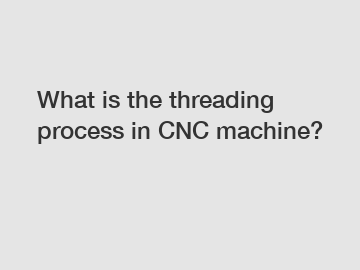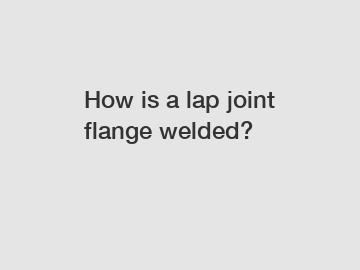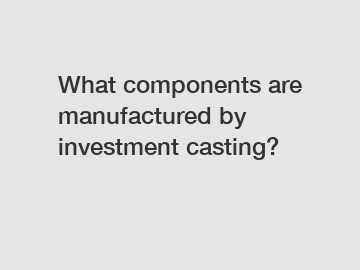What is the threading process in CNC machine?
CNC (Computer Numerical Control) machines have revolutionized the manufacturing industry with their precision and efficiency. One of the most crucial operations performed by these high-tech machines is threading. In this blog, we will delve into the depths of the threading process in CNC machines, exploring its intricate procedures and applications.
Understanding Threading in CNC Machines:
Threading refers to the process of creating helical grooves on a cylindrical surface, enabling the rotation of complementary parts. From simple screws to complex bolts, threading plays an indispensable role in various industries, including automotive, aerospace, and engineering. CNC machines have greatly simplified this intricate process by automating it.

Thread Measurement and Calculation:
The first step in threading involves precise measurement and calculation. Using engineering drawings or specific requirements, the CNC machine operator determines the desired thread type, whether it be metric, unified, or any other specialized variant. Additionally, numerous parameters are taken into account, including the pitch, lead, and thread angle, to ensure accuracy.
Programming the CNC Machine:
Once the measurements are determined, the CNC machine operator proceeds to program the machine accordingly. This involves intricate coding and inputting the necessary commands to execute the specific threading operation. CNC machines utilize standardized programming languages like G-code or M-code to instruct the machine precisely.
Tool Selection and Setup:
Choosing the appropriate cutting tool is critical to achieving precise and repeatable threading results. Factors such as material type, thread diameter, and depth dictate the selection of the cutting tool. Once the tool is selected, it is mounted onto the machine's tool holder, and the necessary adjustments are made to ensure optimal alignment and precision.
Machine Setup and Calibration:
Before kicking off the actual threading process, the machine setup and calibration are crucial. This involves aligning the workpiece accurately and setting the machine parameters such as speed, feed rate, and depth of cut. Skilled operators perform meticulous calibrations to ensure the perfect execution of the threading process.
Recommended article:Mechanical Parts & Fabrication Services
What is the difference between a sludge pump and a mud pump?
What is a sealing strip?
What is the brief description of investment casting?
What is the best pump for pumping slurry?
Exploring the Advantages of Thin Section Open Bearings
Carbide Overlay Plate: The Ultimate Wear Solution
Executing the Threading Process:
Now, it's time for the CNC machine to swing into action. The threading process involves synchronized movements of the cutting tool and the rotating workpiece. The machine's computer system regularly communicates with the precision servomotors, accurately controlling each motion. With higher-end CNC machines, the process can be monitored and adjusted real-time for enhanced precision.
Addressing Threading Challenges:
Threading can be a challenging task due to factors such as material hardness, chip control, and preventing tool wear. CNC machines employ various techniques to overcome these challenges. These include using high-quality cutting tools, optimizing coolant application, and employing specialized threading cycles to mitigate potential issues.
Applications of CNC Machine Threading:
CNC machine threading finds applications across diverse industries. It plays a critical role in the automotive sector for producing engine components such as pistons, crankshafts, and cylinder heads. In aerospace manufacturing, threading is utilized for aerodynamic components, turbine blades, and fasteners. Furthermore, industries like electronics, plumbing, and construction heavily rely on CNC threading for various purposes.
Future Innovations in CNC Machine Threading:
The rapid advancements in CNC technology continue to push the boundaries of threading processes. With the advent of Artificial Intelligence and machine learning, CNC machines are becoming more intuitive and can adapt to evolving manufacturing requirements. Smart machines can automatically optimize threading parameters based on real-time feedback, enhancing efficiency and accuracy further.
Conclusion:
The threading process in CNC machines represents a pivotal aspect of modern manufacturing. From its intricate calculations to the precise execution, threading demands a skilled and technologically advanced approach. CNC machines have revolutionized the way threading is performed, enabling higher efficiency, accuracy, and customization. As technology continues to progress rapidly, we can expect further innovations that will redefine the very concept of threading in CNC machines.
For more hydraulic bucking unit, pipe bucking machine for sale, CNC pipe threading latheinformation, please contact us. We will provide professional answers.
Additional reading:What is a 3 2 valve used in controlling?
All You Need to Know About Throw Out Bearings
How do I choose an actuator for a ball valve?
What are three joints of drill pipe referred to as?
Which Electric Motor Ball Bearing Offers Optimal Efficiency?
Revolutionize Your Inflation Process with Double Ball Air Valve: Boosting Efficiency & Durability!
Ultimate Guide to Food Grade Stainless Steel Parts
207
0
0
Related Articles
-
171
0
0
-
184
0
0
-
200
0
0
-
161
0
0
-
181
0
0
-
184
0
0
-
Which Three-Spool Electric Hydraulic Control Valve is Best for Precision Machinery Performance?
Which Three-Spool Electric Hydraulic Control Valve is Best for Precision Machinery Performance?
205
0
0
-
What are the advantages of purchasing TCN oil seals from a trusted supplier?
What are the advantages of purchasing TCN oil seals from a trusted supplier?
195
0
0










Comments
All Comments (0)